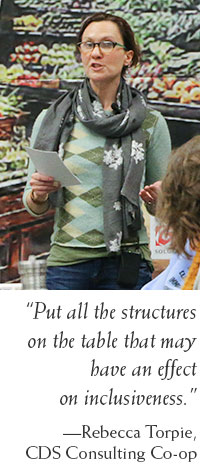
Business introductions are a networking staple—and they run the gamut from the ho-hum ‘We are here to sell you something’ to the dynamic, ‘We love to support communities and make a difference in people’s lives.’
As co-ops continue to seek out ways to innovate, offer more goods and services, and reach out to new communities, it is worth the investment of time and resources to discover the best ways to reach new people and introduce the business to them. Consideration of the proper engagement and how to proceed will come about through research, insight, planning and relationship-building.
Develop a plan
 Nicole Klimek supports businesses with store planning and design as well as marketing and branding. She finds that sometimes businesses give the planning aspect of introducing themselves to a new community short-shrift. “As a first-level activity, you need to create a plan and determine goals.”
Nicole Klimek supports businesses with store planning and design as well as marketing and branding. She finds that sometimes businesses give the planning aspect of introducing themselves to a new community short-shrift. “As a first-level activity, you need to create a plan and determine goals.”
Working with a marketing and communications specialist to help you develop a plan ensures that you will be following a strategic path toward introducing the co-op to new markets and communities. Researching community needs and wants before implementing any outreach initiatives is of vital consideration.
Rebecca Torpie, a marketing and communications consultant, says know who your target audience is, and then prepare tactics and messaging that are appealing and appropriate to them. This also requires understanding your competitors’ and your own co-op’s current situations in the marketplace.
Once the plan is complete, you can begin the work of developing the appropriate communication channels and outreach. It’s also important to share the vision of the co-op’s goals with other people in the co-op and ensure alignment. Review the plan at least quarterly to make sure you are on track with your goals and objectives.
Identify audience and influencers

While the co-op organization may be eager to be introduced to new people and communities, it helps to first know something about the people you want to meet. How are they aligned culturally, and how well is your organization is positioned to receive them? This sort of intentional research is critical. Especially as cooperatives seek to be more economically, racially and culturally diverse as they expand their business.
“Take the time and use resources to look at how systems within the co-op reflect in various ways on diverse groups. As you begin the process, consider cultural awareness training for staff, begin to assess product mix. Put all the structures on the table that may have an effect on inclusiveness,” says Torpie.
Klimek has experience working with many types of co-ops and different cultures, and thinks that doing the work up front to understand people and what they want is so critical. “It informs everything in your project, from what you say, to what sort of aesthetic atmosphere you’d like to create.”
“It’s so important to talk to people. Meet people from the community you want to attract. Learn about them first before you target them. It won’t happen overnight, but these relationships will grow if you give it attention and it is part of your co-op’s mission.” Nicole cited as an example projects she did in Minnesota with Hmong grocers. “It was so important to learn about the regions where people came from, how long they had been in the U.S., what sorts of things they liked to participate in. This is research that can be done but is often overlooked.”
Klimek believes being thorough, careful and respectful is a big part of the discovery process. “If you want to be inclusive, the more you know, the better it will be. You may not be familiar with different cultures, languages or experiences, so it is important to find out. People can assume a lot of things based on stereotypes.”
And as a store designer she understands how atmosphere plays a huge part in how welcome people feel in an environment. On one project she worked on, she learned that light-colored woods (currently all the rage in mainstream building design) didn’t feel friendly or hospitable to the new customers the co-op was trying to attract. She’d also worked with a co-op seeking to be friendly to families with autism. “They wanted to offer autistic-sensitive shopping, which included considerations of lighting, signage, music volume and tactile features.” By doing the applicable research, the co-op was able to deliver that service appropriately. “In all these cases, it’s important to consider the character of the target market.”
Build relationships
 Adam Schwartz is a consultant who assists co-ops with energizing their co-op culture. He believes that relationship building starts with offering an invitation and following up on it to make sure that people know it is genuine. “You have to take the step of actively inviting people. You need to reach out and engage in face-to-face communication and digital media.” Online community forums and social media also allow people to share information and updates.
Adam Schwartz is a consultant who assists co-ops with energizing their co-op culture. He believes that relationship building starts with offering an invitation and following up on it to make sure that people know it is genuine. “You have to take the step of actively inviting people. You need to reach out and engage in face-to-face communication and digital media.” Online community forums and social media also allow people to share information and updates.
And don’t just ask people to join the co-op’s board as the only path to involvement. Schwartz also suggested taking the opportunity to have an inclusive networking events, listening sessions, or developing advisory groups that seek to bring people together and have conversations that lead to better understanding of community needs.
Building relationships also requires that you go beyond extending an invitation. The co-op needs to take the step of going out to partner organizations and communities and introducing the co-op at events and meetings. It’s important to also recognize that there may also be communities that may not have felt welcome or comfortable with the co-op, and those are issues that will also need to be addressed. He advocates a communication tactic with a strong sense of service. “Find out what their hopes and aspirations are for the community, and what the co-op could do to help make those aspirations a reality.”
“We have to be incredibly intentional around doing this,” Schwartz said, and he believes building in systems of accountability will ensure that these efforts are consistent and ongoing. “How else are we going to move the needle and create change in our organizations? We need ongoing support and be able to measure our results.”
Create emotional connections
Once the co-op has made some of those all-important introductions and begun the work of building relationships, it can establish a co-op culture that is focused on reaching out and being of service to people who were once unfamiliar with the co-op. So how do you help people feel like they belong? What is their bond? How is that created?
“When people are receptive, it is possible to create deeper emotional connections to the co-op,” Schwartz said. That’s why he is a proponent of outreach that is deeply engaged in listening, telling and sharing the stories of people and groups involved with the co-op, demonstrating how the co-op has touched their lives. “People want to see themselves reflected in the co-op and the co-op’s impact.”
 Garland McQueen, who works as a temporary general manager for co-ops in transition, often finds himself helping co-ops adapt to working with and reaching out to other communities. He sees a lot of opportunity for co-ops to have a positive impact on the lives of people in a community. “The public is not aware of how co-ops have shaped the lives of so many. We demonstrate the impact of the co-op upon the community and share the impact of the co-op’s mission and operation in areas of local employment, community spirit, social programs, and local producers.”
Garland McQueen, who works as a temporary general manager for co-ops in transition, often finds himself helping co-ops adapt to working with and reaching out to other communities. He sees a lot of opportunity for co-ops to have a positive impact on the lives of people in a community. “The public is not aware of how co-ops have shaped the lives of so many. We demonstrate the impact of the co-op upon the community and share the impact of the co-op’s mission and operation in areas of local employment, community spirit, social programs, and local producers.”
As a co-op educator who teaches high school and at the University of Mary Washington in Virginia, Schwartz knows that people develop a strong connection to co-ops when they can experience the good things about them firsthand.
In his classes, he asks people to work together on a project, and then debrief with other students about what they learned. “The room always erupts in a buzz, and people have a great time. This more than anything convinces me that people being with each other and sharing what they are learning opens minds to what is possible. I believe it is incumbent on those of us who work in cooperatives to prepare the next generation of leaders, lower the obstacles to participation, and engender a sense of empowerment.”
Have more questions?
Get in touch with one of our consultants.
